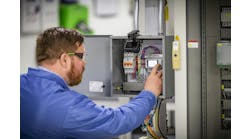After working as a semiconductor process engineer, Hank Hogan hung up his cleanroom suit and now writes about process control and other technologies from Austin.
These devices bring motors up to speed in a controlled fashion, allowing machines to get going without a jolt. That saves mechanical wear-and-tear and could save money in other ways. For instance, the use of a soft starter can avoid the fees associated with exceeding a limit by minimizing the starting current inrush.
Soft starters work by temporarily limiting power available to a motor, thereby allowing for a more leisurely start than would be the case otherwise. That can lead to smoother machine startup and better overall plant operation by avoiding line voltage dips, says Stan Komander, product manager for soft starters at ABB Baldor.
However, before deciding on a soft starter, it’s important to ask a basic question: Why get one? Consider a scenario in which a protective device trips during a motor’s start and the motor has trouble getting up to speed for an unrelated reason: insufficient line power or undersizing. It might seem that the answer would be to go with a soft starter, but that would be a mistake, according to Komander. “The soft starter will only starve the motor of necessary current,” he says. “It will only provide less power to start. So if the motor is not starting across the line, well the soft starter will not help.”
[pullquote]Soft starters can be the right solution to avoid paying a penalty and to keep a plant running, Komander adds. With regard to the first, utilities may have a tiered pricing structure, with users paying extra for exceeding a set current limit.
As for smoother plant operation, visual indications of motor startup may be seen in lights dimming because of a line voltage dip brought about as current rushes in. That drop can be as much as 40%, enough to cause problems with protective devices and control circuits. A soft starter can avoid this problem by reducing initial motor voltage to a lower value, such as 30%. That will then be ramped up over a user-selected period of time until full voltage is reached.
Also Read: Smart Motor Tips
ABB Baldor’s soft starters use silicon controlled rectifiers (SCRs) with two per power phase. The SCRs only conduct during part of the electrical power cycle, which has the effect of reducing average voltage and leads to a soft start. Hence, the motor accelerates without sudden and abrupt changes, and so there are no mechanical jolts and jerks, Komander points out.
It’s important to properly size a soft starter and match it to the application, says Nichole Angiola, product manager for soft starters at Eaton. A longer ramp time means that the SCRs are being used longer, which creates heat and potentially damages them. Getting that sizing right involves paying attention to motor parameters that are sometimes overlooked.
“It is recommended to size the soft starter by the motor full load Amps current, not the power rating,” Angiola says.
She adds that the inrush current of a large motor can be as high as 10 times the full load Amps, but usually soft starters are sized to accommodate three or four times this figure. If a motor does indeed pull at the higher level, then the soft starter will have to be oversized. A benefit is that a soft starter will significantly reduce a large inrush current spike and will, therefore, mitigate associated costs and problems.
Another factor to consider is the application. Loads such as pumps present particular problems, since turning a pump on or off can lead to what is called a water hammer effect. As the name implies, the starting or stopping of water flow can act like a hammer, which can rattle plumbing and lead to disaster. For that reason some soft starters have special algorithms that eliminate this effect and thereby extend the life of pumps and other components, Angiola says.
Starts per hour is another concern, she adds. “Soft starters are rated for a certain number of starts per hour,” says Angiola. “If the application requires more, then the soft starter must be sized appropriately to eliminate premature SCR failure.”
Joe Kimbrell, product manager of drives, motors, and motion control at AutomationDirect, adds there is another application aspect to consider. If the speed of a motor must be varied, then a soft starter is not a fit. But, if the application is one where the speed is constant, then the payoff to taking things slowly at the beginning can be substantial.
Take the case of a loaded horizontal conveyor, Kimbrell says. A great deal of torque is needed initially, but not nearly as much when everything is up to speed. Thus, the motors may only be lightly loaded during normal operation. However, no matter the load, those motors will consume the same internal, or magnetizing, current, and it is here that an intelligent soft starter can cut energy consumption by as much as 10%.
“What the soft starter does is it lowers the voltage to the motor, lowering the magnetizing current, and that’s how you end up saving money and energy,” Kimbrell says.
As for selecting a soft starter in those cases where smoother operation is desired, the key is to look at a motor’s voltage and full load current. Voltage is straightforward, but current can be more involved, according to Kimbrell. A soft starter can be rated for several different currents based upon the application. A longer programmed ramp time results in a lower allowable current due to heat buildup in the starter.
Finally, some soft starters are simple devices, while others are more complex and advanced. The latter costs more, but the added communication and data-logging capabilities may make the extra expense worthwhile. For instance, a soft starter can provide information about a motor during every initiation sequence. This data is in addition to whatever information the motor itself is supplying, and the extra intelligence can prove useful.
“You can trend the actual current the motor is drawing and if you see it increasing over time you can use this information for predictive maintenance, not preventive,” says Kimbrell. “You’re actually looking for symptoms of problems before they become catastrophic.”



